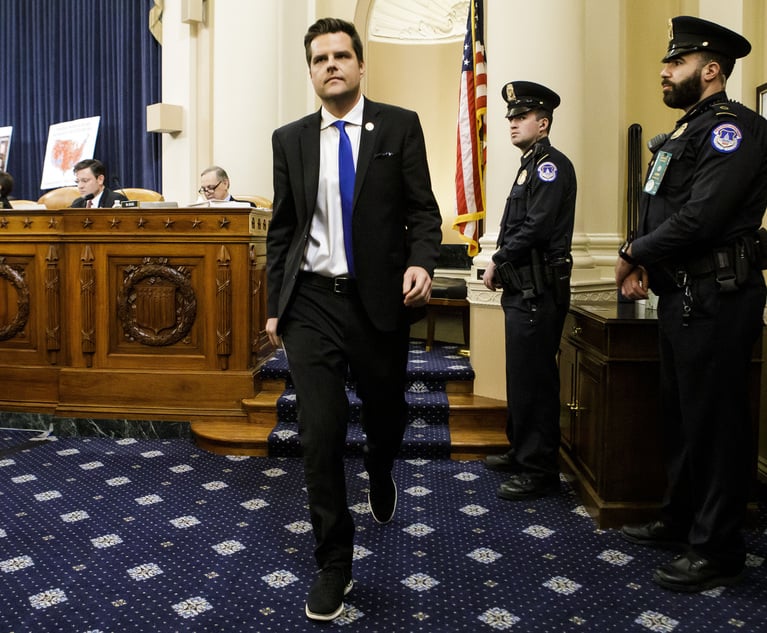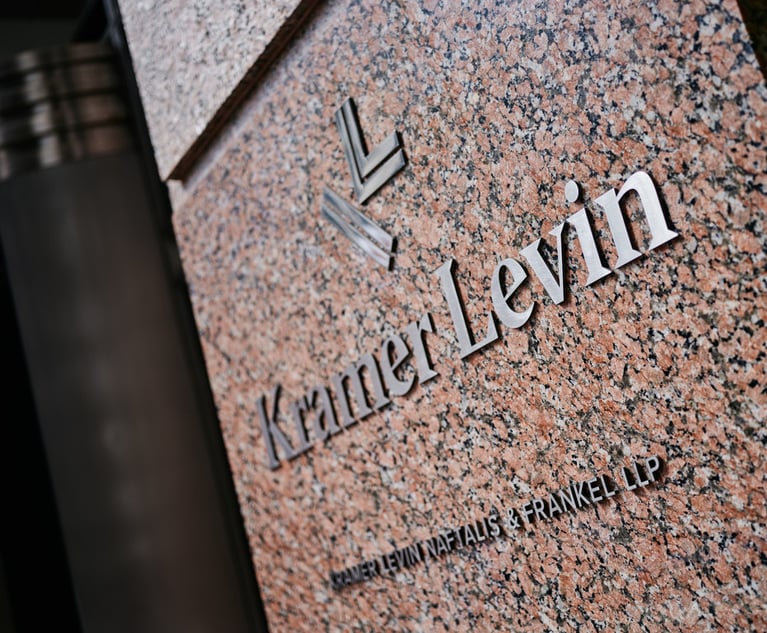An Evanescent Supreme Court Nomination: The Gov. Mario M. Cuomo Story
An example from the early '90s offers some perspective on the subject of the looming confirmation battle of a Supreme Court nominee. The name of then-Governor Mario M. Cuomo was floated, and after a short tease, disappeared into an historical footnote. What happened?
July 17, 2018 at 02:30 PM
5 minute read
 Angst is brewing over the confirmation battle for the Justice Anthony Kennedy seat on the Supreme Court of the United States. An example from the early '90s offers some perspective on the subject. The name of then-Governor Mario M. Cuomo was floated, and after a short tease, disappeared into an historical footnote. What happened? It was reliably reported that President Bill Clinton considered (some said, even offered) Cuomo the nomination to SCOTUS. Speculation ensued that Cuomo, if appointed, would become the jurisprudential equalizer to fellow Queens New York native, Justice Nino Scalia. Alas, the rousing intellectual debates around the super-secret Court conference table never came to be. A recent book about the late Governor (“ American Cicero” by Professor Saladin Ambar) confers the classical mantle of Cicero on him - in recognition of the oratorical skills that he projected nationally in heralded speeches in the 1980s at the Democratic National Convention in San Francisco and at Notre Dame University. To understand this Cuomo fellow in this SCOTUS context, Socrates and his pithy principle of “Know Thyself” is useful. To set the stage, it is well to recall Cuomo's earlier dalliance of a run for the presidency in 1988. A national campaign would have necessitated his entrusting his message and ultimate success to many strangers. That was alien to his comfort zone, as he liked working close to his own nest and vest. He spoke often as a man who saw himself as the proud product of the neighborhood Mom & Pop shop. Make no mistake, he was also an ambitious man, confident about his God-given talents and strengths. Yet, his tightly tethered ambition was displayed when he ended another of his less-renowned speeches - his first Inaugural as Governor - by publicly promising his deceased and revered father that he would not be distracted by the cérémonie ( the trappings of high office) . The unavoidable modus operandi to run for president was, thus, incompatible with the figure he saw reflected through his Socratic mirror. That realization probably would have convinced him to stay put on his New York home court turf, while the hilarious image of the plane idled away on the Albany Airport tarmac. |
Angst is brewing over the confirmation battle for the Justice Anthony Kennedy seat on the Supreme Court of the United States. An example from the early '90s offers some perspective on the subject. The name of then-Governor Mario M. Cuomo was floated, and after a short tease, disappeared into an historical footnote. What happened? It was reliably reported that President Bill Clinton considered (some said, even offered) Cuomo the nomination to SCOTUS. Speculation ensued that Cuomo, if appointed, would become the jurisprudential equalizer to fellow Queens New York native, Justice Nino Scalia. Alas, the rousing intellectual debates around the super-secret Court conference table never came to be. A recent book about the late Governor (“ American Cicero” by Professor Saladin Ambar) confers the classical mantle of Cicero on him - in recognition of the oratorical skills that he projected nationally in heralded speeches in the 1980s at the Democratic National Convention in San Francisco and at Notre Dame University. To understand this Cuomo fellow in this SCOTUS context, Socrates and his pithy principle of “Know Thyself” is useful. To set the stage, it is well to recall Cuomo's earlier dalliance of a run for the presidency in 1988. A national campaign would have necessitated his entrusting his message and ultimate success to many strangers. That was alien to his comfort zone, as he liked working close to his own nest and vest. He spoke often as a man who saw himself as the proud product of the neighborhood Mom & Pop shop. Make no mistake, he was also an ambitious man, confident about his God-given talents and strengths. Yet, his tightly tethered ambition was displayed when he ended another of his less-renowned speeches - his first Inaugural as Governor - by publicly promising his deceased and revered father that he would not be distracted by the cérémonie ( the trappings of high office) . The unavoidable modus operandi to run for president was, thus, incompatible with the figure he saw reflected through his Socratic mirror. That realization probably would have convinced him to stay put on his New York home court turf, while the hilarious image of the plane idled away on the Albany Airport tarmac. |
A Possible Nomination
That set the stage for the next dalliance – a possible nomination to the Supreme Court. This supreme capstone to Cuomo's public and lawyerly career seemed a perfect fit. Cuomo's mother's dream for him, as he often told the story, that he might become a judge, would also be fulfilled. Despite his tongue-in-cheek wisecrack about not wanting to top off his career hidden under a black robe, he held the judicial process in the highest regard. Privately, Cuomo also fantasized the debates he might have with the highly respected intelligence of his diametrically opposite number – Justice Antonin Scalia – two American-Italian immigrant success stories, wearing respective St. John's - Harvard “tee” shirts under their robes. Socrates and the Know Thyself principle, however, popped up anew. An astute student of history, Cuomo would have weighed the temporal dynamic of confirmation. If he accepted the nomination, he would have been the first post-Robert Bork Senate piñata. Political party retribution hung heavily in the poisoned confirmation atmosphere – as it has ever since - skewing the process in a regrettable way. Cuomo enjoyed a feisty litigator reputation and intellectual debate about ideas, big and small. So, the trial combatant, the former law professor at St. John's highly skilled in the Socratic Teaching Method, faced a new crossroad. Should he enter the transmogrified confirmation ring, or once again stay put? This time he would be in control of his own destiny – no long-arm delegations to unknown others. Occasionally caricatured as “Hamlet on the Hudson,” Cuomo thus faced his “to be or not to be” moment. Picture it this way: The nominee, then and now, sits alone at the Senate confirmation hearing table, primed (and biting one's tongue, as it were), to reply respectfully and diplomatically by saying absolutely nothing of consequence. Every utterance on every issue to many Senate interlocutors (neither a Cicero nor a Socrates among them) would be counter intuitively interdicted – a Trappist-like silence. Governor Mario Cuomo (full disclosure: a friend who appointed me to the New York State Court of Appeals in 1987) well knew his impatience for this kind of inane kabuki. Cuomo knew his natural disposition as a person of combative rigor and intellectual integrity would not survive sitting there without blunt and serious ripostes. He probably grimaced at the Socratic and Hamletian reflections and decided to pass on the offered hemlock. Joseph W. Bellacosa retired from his position as associate judge on the state Court of Appeals in 2000. He also served as dean of St. John's Law School.
This content has been archived. It is available through our partners, LexisNexis® and Bloomberg Law.
To view this content, please continue to their sites.
Not a Lexis Subscriber?
Subscribe Now
Not a Bloomberg Law Subscriber?
Subscribe Now
NOT FOR REPRINT
© 2024 ALM Global, LLC, All Rights Reserved. Request academic re-use from www.copyright.com. All other uses, submit a request to [email protected]. For more information visit Asset & Logo Licensing.
You Might Like
View All
From ‘Deep Sadness’ to Little Concern, Gaetz’s Nomination Draws Sharp Reaction From Lawyers
7 minute read
Deposing Former Mayor Bill de Blasio; Misrepresentations To Induce Investment: This Week in Scott Mollen’s Realty Law Digest

Post-Pandemic Increase in Live Events Prompts Need for Premise Liability Action
7 minute readTrending Stories
- 1The Growing PFAS Morass: Why Insurance Should Cover These Products Liability Claims
- 2Dallas Jury Awards $98.65M in Botham Jean Killing by Dallas Officer
- 3In Talc Bankruptcy, Andy Birchfield Skipped His Deposition. Could He Face Sanctions?
- 4Pharmaceutical Patents: Benefits and Challenges
- 5Where Do Web-Tracking Class Actions Belong? 8th Circuit Weighs the Issue
Who Got The Work
Michael G. Bongiorno, Andrew Scott Dulberg and Elizabeth E. Driscoll from Wilmer Cutler Pickering Hale and Dorr have stepped in to represent Symbotic Inc., an A.I.-enabled technology platform that focuses on increasing supply chain efficiency, and other defendants in a pending shareholder derivative lawsuit. The case, filed Oct. 2 in Massachusetts District Court by the Brown Law Firm on behalf of Stephen Austen, accuses certain officers and directors of misleading investors in regard to Symbotic's potential for margin growth by failing to disclose that the company was not equipped to timely deploy its systems or manage expenses through project delays. The case, assigned to U.S. District Judge Nathaniel M. Gorton, is 1:24-cv-12522, Austen v. Cohen et al.
Who Got The Work
Edmund Polubinski and Marie Killmond of Davis Polk & Wardwell have entered appearances for data platform software development company MongoDB and other defendants in a pending shareholder derivative lawsuit. The action, filed Oct. 7 in New York Southern District Court by the Brown Law Firm, accuses the company's directors and/or officers of falsely expressing confidence in the company’s restructuring of its sales incentive plan and downplaying the severity of decreases in its upfront commitments. The case is 1:24-cv-07594, Roy v. Ittycheria et al.
Who Got The Work
Amy O. Bruchs and Kurt F. Ellison of Michael Best & Friedrich have entered appearances for Epic Systems Corp. in a pending employment discrimination lawsuit. The suit was filed Sept. 7 in Wisconsin Western District Court by Levine Eisberner LLC and Siri & Glimstad on behalf of a project manager who claims that he was wrongfully terminated after applying for a religious exemption to the defendant's COVID-19 vaccine mandate. The case, assigned to U.S. Magistrate Judge Anita Marie Boor, is 3:24-cv-00630, Secker, Nathan v. Epic Systems Corporation.
Who Got The Work
David X. Sullivan, Thomas J. Finn and Gregory A. Hall from McCarter & English have entered appearances for Sunrun Installation Services in a pending civil rights lawsuit. The complaint was filed Sept. 4 in Connecticut District Court by attorney Robert M. Berke on behalf of former employee George Edward Steins, who was arrested and charged with employing an unregistered home improvement salesperson. The complaint alleges that had Sunrun informed the Connecticut Department of Consumer Protection that the plaintiff's employment had ended in 2017 and that he no longer held Sunrun's home improvement contractor license, he would not have been hit with charges, which were dismissed in May 2024. The case, assigned to U.S. District Judge Jeffrey A. Meyer, is 3:24-cv-01423, Steins v. Sunrun, Inc. et al.
Who Got The Work
Greenberg Traurig shareholder Joshua L. Raskin has entered an appearance for boohoo.com UK Ltd. in a pending patent infringement lawsuit. The suit, filed Sept. 3 in Texas Eastern District Court by Rozier Hardt McDonough on behalf of Alto Dynamics, asserts five patents related to an online shopping platform. The case, assigned to U.S. District Judge Rodney Gilstrap, is 2:24-cv-00719, Alto Dynamics, LLC v. boohoo.com UK Limited.
Featured Firms
Law Offices of Gary Martin Hays & Associates, P.C.
(470) 294-1674
Law Offices of Mark E. Salomone
(857) 444-6468
Smith & Hassler
(713) 739-1250







